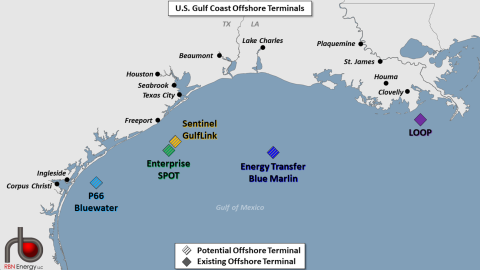In the race to build the next deepwater crude oil export terminal along the U.S. Gulf Coast, there’s a lot of competition but one project now has a clear advantage: Enterprise Product Partners’ planned Sea Port Oil Terminal (SPOT), which has made the most progress in moving through the regulatory morass and announced that it had received its deepwater port license on April 9. In today’s RBN blog, we provide an update on SPOT’s progress and look at some of its inherent advantages, including a potentially shorter time to market and extensive pipeline connectivity.
Part 1 of this series made the case for constructing at least one of the four deepwater export projects now under development. As we’ve blogged about often (see May Exports Be With You), U.S. crude export volumes took off in the 2010s and are expected to continue growing along with production throughout the 2020s, driving the market to seek the most efficient export options. The projects under development offer a number of potential benefits to shippers and customers alike. Those include the ability to fully load a Very Large Crude Carrier (VLCC) and the economies of scale that come with that, a reduction of reverse lightering and the corresponding decrease in emissions, and freed-up access on congested ship channels for other exports such as NGLs, refined products and ammonia. There is only one operational deepwater crude oil terminal with a single-point mooring (SPM) in the U.S.: the Louisiana Offshore Oil Port (LOOP; purple diamond in Figure 1 below).
Figure 1. U.S. Gulf Coast Offshore Terminals. Source: RBN
Join Backstage Pass to Read Full Article











